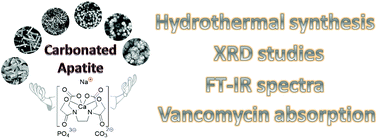Hydrothermal synthesis of perfectly shaped micro- and nanosized carbonated apatite†
Abstract
Although carbonated apatite (CAp)-based nanomaterials are considered suitable as bone substitutes, for effective treatment, it is necessary to develop synthetic methods for preparing particles with controlled sizes and morphologies. Herein, perfectly shaped CAp crystals with uniform sizes and morphologies were successfully obtained by the reaction of the N,N′-ethylenediaminetetraacetic acid complex of Ca2+ (Ca[EDTA]) with sodium (di)hydrophosphate and sodium (hydro)carbonate under mild conditions (120–160 °C, 1–5 h, pH ∼6 or ∼9). Depending on the initial pH value, reaction time, temperature, and reagent ratio, a wide range of plate-like, rod-like, and prism-like crystal species with different aspect ratios were synthesized for the first time. X-ray diffraction analysis confirmed that the obtained samples were mainly B-type CAp species. Energy-dispersive X-ray spectroscopy revealed high Na/Ca ratios (up to 0.3), whereas Fourier transform infrared spectroscopy and thermogravimetric analysis (TGA) confirmed high CO32− contents (C/P ratios up to 0.48). The TGA data also showed that the thermal decomposition of the obtained CAp species involved step-by-step dehydration and CO2 elimination. Furthermore, sintering of the CAp samples revealed the optimal temperature (850 °C) for preparing the apatite phase, which is highly active for vancomycin absorption and therefore has potential for applications in biomedicine.



 Please wait while we load your content...
Please wait while we load your content...